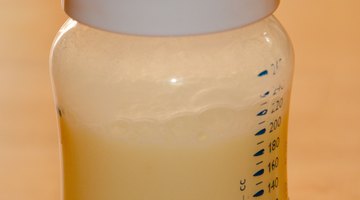Home Remedies to Help Babies Stop Breast-Feeding
Breast-feeding has numerous proven health benefits for your baby, but in some cases you can't -- or don't want to -- continue breast-feeding. You can help your baby make the transition from breast to bottle or cup, depending on his age, by taking it slow and watching your child for cues that he's ready to make this step. You might also suffer some physical discomfort when you stop nursing until your breasts adjust and stop producing milk.
Put Limits on Nursing
An infant won't understand if you explain that the mommy milk machine is shutting down production, but an 18-month-old or older child will, at least to a limited extent. Limit your nursing to a certain chair or a certain time of day rather than having the milk bar open at all hours. It's normal for an older child to express sorrow and anger over losing what has been a major source of comfort as well as nutrition for his entire life. It might be easier for your baby to take a bottle from someone other than yourself at first or to have someone else put him to bed if he's used to nursing before going to sleep.
Change Positions

How to Know When to Change Breasts While Breastfeeding
Learn More
A breast-fed baby will automatically begin to root and look for the breast when you hold him in the nursing position and he smells your milk. Hold him in different positions for feeding when you switch to a bottle. Hold him in a more upright position or on your knees with his head facing you at first. Don't prop the bottle; your baby still needs the closeness that he got during breast-feeding. Give him plenty of cuddle time after the feeding.
Try Different Nipples
All bottle systems have slightly different nipples. If your baby takes a pacifier, you already know that not all nipples will do -- your baby probably has a preference. Some babies will do better with a nipple that mimics the shape of the breast, while others will do better with a nipple of a completely different shape. Buy just one or two different bottles rather than a whole set to start, until you figure out which your baby prefers.
Drying Up Your Milk

I Stopped Breastfeeding. Can You Start Again Once Your Milk Has Dried Up?
Learn More
If you've already established a good milk supply, it's not easy to turn off the faucet on short notice. If you have time, dropping one feeding per day decreases your milk supply gradually, because breast-feeding is the original supply-and-demand system. Your body makes the same amount of milk your baby takes out. If you need to stop nursing quickly, be prepared for some discomfort. Apply ice packs to your sore breasts and express only as much as you need to to relieve the discomfort. Don't use binders, which can cause blocked ducts; wear a good supportive sports bra instead. Cabbage leaves can help; apply them directly to your breasts.










